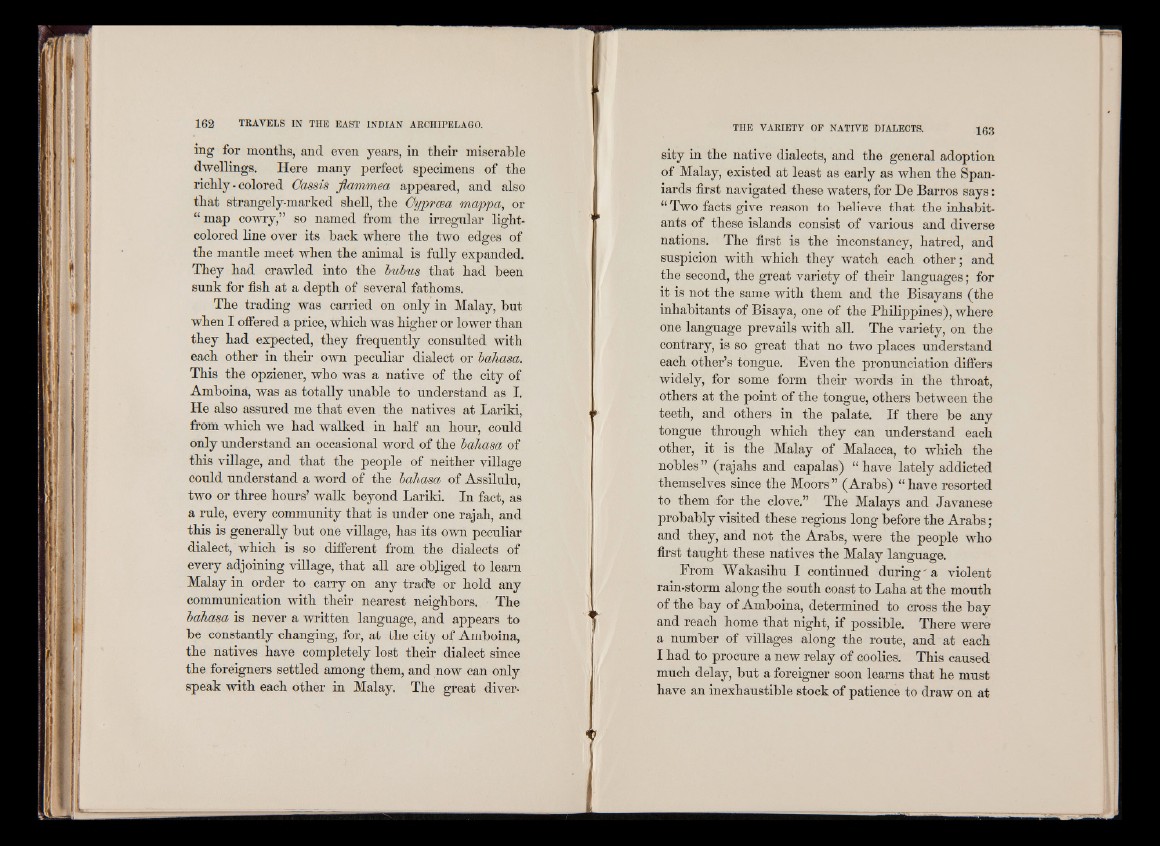
ing for months, and even years, in their miserable
dwellings. Here many perfect specimens of the
richly - colored Cassis flammea appeared, and also
that strangely-marked shell, the Cyprcea mappa, or
“ map cowry,” so named from the irregular light-
colored line over its back where the two edoges of
the mantle meet when the animal is fully expanded.
They had crawled into the bubus that had been
sunk for fish at a depth of several fathoms.
The trading was carried on only in Malay, but
when I offered a price, which was higher or lower than
they had expected, they frequently consulted with
each other in their own peculiar dialect or bahasa.
This the opziener, who was a native of the city of
Amboina, was as totally unable to understand as I.
He also assured me that even the natives at Lariki,
from which we had walked in half an hour, could
only understand an occasional word of the bahasa of
this village, and that the people of neither village
could understand a word of the bahasa of Assilulu,
two or three hours’ walk beyond Lariki. In fact, as
a rule, every community that is under one rajah, and
this is generally but one village, has its own peculiar
dialect, which is so different from the dialects of
every adjoining village, that all are objiged to learn
Malay in order to carry on any trade or hold any
communication with their nearest neighbors. The
bahasa is never a written language, and appears to
be constantly changing, for, at the city of Amboina,
the natives have completely lost their dialect since
the foreigners settled among them, and now can only
speak with each other in Malay. The great diversity
in the native dialects, and the general adoption
of Malay, existed at least as early as when the Spaniards
first navigated these waters, for De Barros says:
“ Two facts give reason to believe that the inhabitants
of these islands consist of various and diverse
nations. The first is the inconstancy, hatred, and
suspicion with which they watch each other; and
the second, the great variety of their languages; for
it is not the same with them and the Bisayans (the
inhabitants of Bisaya, one of the Philippines), where
one language prevails with all. The variety, on the
contrary, is so great that no two places understand
each other’s tongue. Even the pronunciation differs
widely, for some form their words in the throat,
others at the point of the tongue, others between the
teeth, and others in the palate. If there be any
tongue through which they can understand each
other, it is the Malay of Malacca, to which the
nobles” (rajahs and capalas) “ have lately addicted
themselves since the Moors” (Arabs) “ have resorted
to them for the clove.” The Malays and Javanese
probably visited these regions long before the Arabs;
and they, and not the Arabs, were the people who
first taught these natives the Malay language.
From W akasihu I continued d u rin g 'a violent
rain-storm along the south coast to Laha at the mouth
of the bay of Amboina, determined to cross the bay
and reach home that night, if possible. There were
a number of villages along the route, and at each
I had to procure a new relay of coolies. This caused
much delay, but a foreigner soon learns that he must
have an inexhaustible stock of patience to draw on at